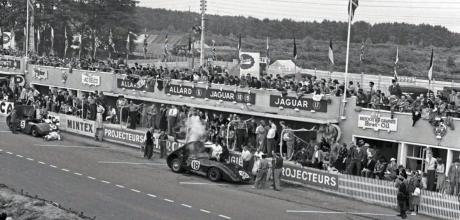Jaguar retires from Le Mans 24 Hours race, June 14-15 1952
Due to Jaguar’s dominant victory of the 1951 Le Mans 24 Hours race with the C-type, success the following year seemed a certainty. The car had been almost uncatchable, plus Jaguar’s large stable of contracted drivers, that included (Sir) Stirling Moss, Duncan Hamilton and Peter Whitehead, were some of the best around at the time. But due to a catastrophic redesign of the C-type leading up to the 1952 race, a fairy-tale second win wasn’t to be.
The catalyst for the change was the Mille Miglia in May 1952 when Moss and Jaguar’s test driver, Norman Dewis (OBE), took part in the notoriously hard 1,000-mile road race in a C-type. Although their entry was more to test the embryonic disc brake system, the pair still ran strongly, only retiring from third after Moss hit a rock during the descent of the Raticosa Pass which broke the steering rack.
Yet due to Karl King’s Mercedes-Benz 300SL W198 making up four minutes on Moss after the start, the British driver was concerned about the performance of the car, especially since the German company was returning to Le Mans that year for the first time since 1933. And so while still in Italy, Moss sent a telegram to Jaguar chairman, (Sir) William Lyons, that said simply, “Must have more speed for Le Mans.”
Jaguar’s aerodynamicist and the man behind the C-type, Malcolm Sayer, hastily designed a new elongated nose and longer tail for the C-type to try and increase its top speed on the long straights at Le Mans. This necessitated mounting the header tank on the bulkhead which would later prove to be disastrous.
With no opportunity for testing, it was only found during practice that the redesign resulted in all three cars overheating. “Hot water seemed to be circulating straight from the engine to the header tank,” said Moss in his 1987 book, My Cars, My Career, “so it inevitably boiled.”
According to Moss, it was Lyons himself who ordered two of the cars to be given standard radiators, stealing parts from one C-type that was passing LeMans after returning to Coventry following the Monaco Grand Prix in early June, plus Duncan Hamilton’s own example that was heading to Portugal for an event later that month. The changes necessitated Jaguar’s mechanics to hammer bulges into the bonnet, therefore ruining Sayer’s sleek, new design.
Although the three Jaguars qualified poorly, Moss (17) made his customary lightning start and by the time the pack had reached the Dunlop Bridge he was already up to fourth, later reaching as high as second. Sadly, his car stopped 24 laps later due to a small piece of the chain tensioner spring snapping off and working its way up the oil suction pipe until it stuck under the relief valve, holding it open. The C-type that didn’t have the standard radiator fitted, number 19 that was driven by Peter Whitehead and Peter Walker, overheated and retired after just 16 laps.
By slipstreaming slower competitors to try and keep the temperature down, the drivers of car 18, Tony Rolt and Duncan Hamilton, managed to keep their car going until the early evening. But it too eventually pulled into the pits permanently (pictured here) due to head gasket failure. As Moss wrote in his book 35 years later, “It was an unmitigated Jaguar disaster.”
Yet it would be the last one Jaguar would suffer from. After being returned to its original design for the 1953 race, the C-type finished first, second and fourth at Le Mans, while the D-type would come to dominate the race between 1955-1957.


